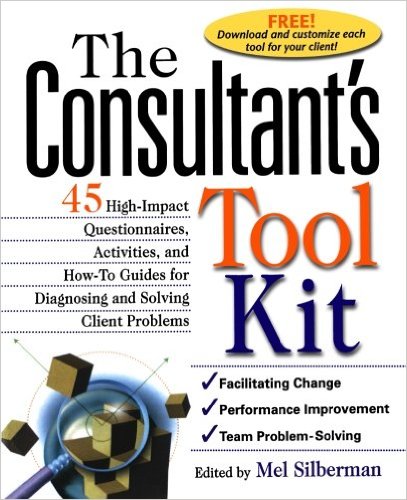The Consultant's Toolkit: A Comprehensive Guide to High-Impact Tools and Techniques
Introduction
The role of a consultant is multifaceted, demanding a deep understanding of business challenges, the ability to diagnose complex problems, and the skill to design effective solutions. To effectively navigate this complex landscape, consultants often rely on a toolkit of proven techniques and tools. This white paper delves into a curated selection of 45 high-impact questionnaires, activities, and how-to guides from Mel Silberman's "The Consultant's Toolkit." These tools are designed to help consultants efficiently diagnose and solve client problems, leading to impactful and sustainable solutions.
Understanding the Toolkit's Core Principles
Before diving into the specific tools, it's essential to grasp the underlying principles that guide their effectiveness:
- Client-Centric Approach: All tools are designed to engage clients actively, ensuring their perspectives and needs are at the forefront.
- Action-Oriented Focus: The toolkit emphasizes practical solutions, encouraging clients to take immediate steps towards improvement.
- Collaborative Problem-Solving: The tools foster collaboration between the consultant and client, leveraging collective wisdom to generate innovative solutions.
- Data-Driven Insights: Many tools incorporate data collection and analysis to inform decision-making and measure progress.
Key Tool Categories and Their Applications
The toolkit is organized into several categories, each addressing specific consulting challenges:
- Diagnosis and Assessment
- Client Needs Assessment: A structured questionnaire to uncover client pain points and aspirations.
- Organizational Culture Assessment: A tool to evaluate the organization's culture and identify areas for improvement.
- Team Performance Assessment: A diagnostic tool to assess team dynamics, communication, and collaboration.
- Problem-Solving and Decision-Making
- Root Cause Analysis: A structured approach to identify the underlying causes of problems.
- Force Field Analysis: A visual tool to analyze the factors driving and restraining change.
- Decision Matrix: A decision-making tool to weigh options against criteria.
- Change Management and Implementation
- Change Impact Assessment: A tool to evaluate the potential impact of change initiatives.
- Communication Plan Template: A guide to develop effective communication strategies.
- Resistance Management Strategies: Techniques to address resistance to change.
- Team Building and Development
- Team Effectiveness Questionnaire: A tool to assess team performance and identify areas for improvement.
- Team Building Activities: A variety of exercises to enhance team cohesion and collaboration.
- Conflict Resolution Strategies: Techniques to address and resolve interpersonal conflicts.
How to Effectively Utilize the Toolkit
To maximize the impact of these tools, consider the following tips:
- Tailor to the Client: Adapt the tools to fit the specific needs and context of each client engagement.
- Active Listening and Empathy: Use open-ended questions and active listening to build rapport and gain deep insights.
- Facilitation Skills: Employ effective facilitation techniques to guide discussions and keep the group focused.
- Data Analysis and Interpretation: Use data analysis to identify trends, patterns, and areas for improvement.
- Action Planning: Work with clients to develop clear action plans and timelines for implementing solutions.
- Follow-Up and Evaluation: Regularly monitor progress and evaluate the effectiveness of the implemented solutions.
Conclusion
The Consultant's Toolkit provides a valuable resource for practitioners seeking to enhance their consulting practice. By effectively employing these tools, consultants can improve their ability to diagnose complex problems, design innovative solutions, and drive positive change within organizations. By combining these tools with strong interpersonal skills and a deep understanding of business principles, consultants can elevate their impact and deliver exceptional results for their clients.
References
- Silberman, M. (2004). The Consultant's Toolkit: 45 High-Impact Questionnaires, Activities, and How-To Guides for Diagnosing and Solving Client Problems.
Note: To create a truly comprehensive white paper, consider incorporating real-world case studies, expert insights, and additional references to further strengthen the document's credibility and relevance.



